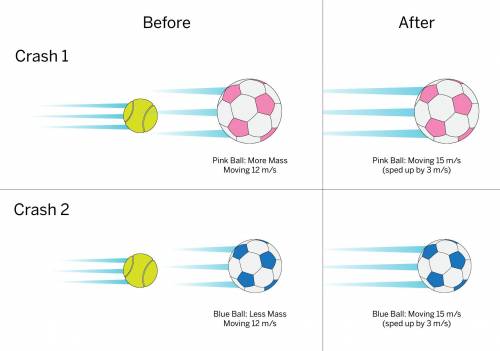
Physics, 18.11.2020 20:00 sairaanwar67
Mateo and Jackie were on a playground rolling some different-sized balls to get them to crash. They used a tennis ball (the same mass) in both crashes. They tried two soccer balls—a pink one (more mass) for Crash 1 and a blue one (less mass) for Crash 2.
Mateo and Jackie want to know what happened to the tennis ball. Use information from the diagram to answer.
In which crash did the tennis ball experience a stronger force? How do you know?
a
Crash 1; the force on the soccer ball was stronger in this crash, so the force on the tennis ball was also stronger.
b
There was no force on the tennis ball. In each crash, only the soccer ball experienced a force.
c
It was the same in both crashes. The soccer ball changed speed by the same amount in each crash, so the force on the tennis ball was the same both times.
d
The diagram doesn’t tell you anything about the force on the tennis ball. It only gives information about the force on the soccer balls.


Answers: 3


Another question on Physics

Physics, 21.06.2019 18:20
Find the vertex(use the completing the square method), findthe x- and y-intercepts, and sketch the graph offunction. y = 2x2 + 4x - 1
Answers: 3

Physics, 22.06.2019 04:40
Steam enters an adiabatic diffuser at 150 kpa and 1208c with a velocity of 550 m/s. determine the minimum velocity that the steam can have at the outlet when the outlet pressure is 300 kpa.
Answers: 3

Physics, 22.06.2019 06:00
The magnetic field inside a superconducting solenoid is 4.50 t. the solenoid has an inner diameter of 6.20 cm and a length of 26.0 cm. determine (a) the magnetic energy density in the field and (b) the energy stored in the magnetic field within the solenoid.
Answers: 2

Physics, 22.06.2019 11:10
Consider an insulating crystal, made up of layers of atoms. what form would you expect the temperature dependence of the phonon heat capacity to approach at extremely low temperatures if the interlayer coupling is i)very strong (rigid coupling), and ii) very weak. explain.
Answers: 3
You know the right answer?
Mateo and Jackie were on a playground rolling some different-sized balls to get them to crash. They...
Questions

Advanced Placement (AP), 20.10.2020 07:01

World Languages, 20.10.2020 07:01

Mathematics, 20.10.2020 07:01

Health, 20.10.2020 07:01



Mathematics, 20.10.2020 07:01



Physics, 20.10.2020 07:01

History, 20.10.2020 07:01

Biology, 20.10.2020 07:01

Spanish, 20.10.2020 07:01


History, 20.10.2020 07:01

Mathematics, 20.10.2020 07:01

English, 20.10.2020 07:01

Chemistry, 20.10.2020 07:01

Chemistry, 20.10.2020 07:01



